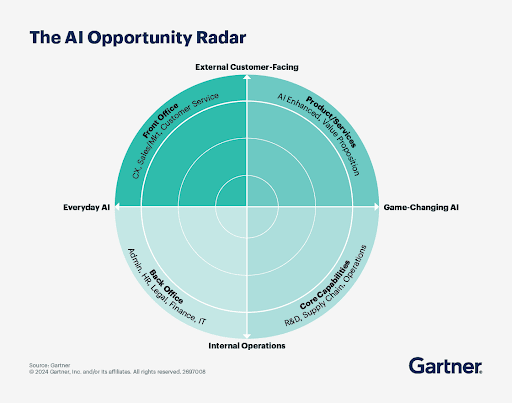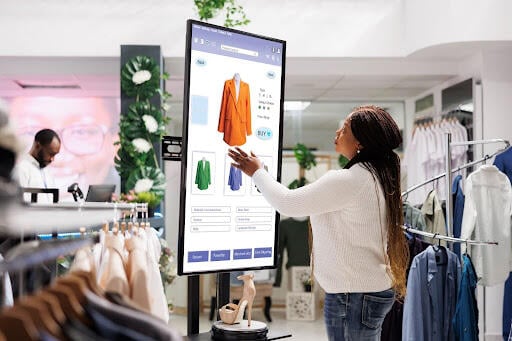How Generative AI in Retail Is Boosting Sales in 2026
In 2026, retail will be completely revolutionized by generative AI. Consumer shopping, supply chain optimization, and personalized marketing will be achievable in ways that were unthinkable in previous years.
It is predicted that by next year, 75% of organizations will have implemented generative AI to generate synthetic data, hyper-personalized product offerings, and dynamic customer experiences. So what does this mean for retail businesses?

The technology is already yielding measurable returns: it's making operations more efficient with regards to both cost and time, helping to enhance customer satisfaction, and driving real revenue growth.
In this article, we will touch upon the most relevant areas where generative AI is making its presence felt in retail and offer valuable applications, efficient implementation strategies, and AI business future outlooks.
Impact of Generative AI on the Retail Industry

To understand how generative AI is reshaping the retail landscape, we sought insights from industry leader Vineet Gupta, founder of 2xSaS. When discussing the role of generative AI in retail, she stated:
“Generative AI is a game-changer for retail businesses. From dynamic product content to hyper-personalized customer journeys, it’s helping brands operate smarter, faster, and with greater creativity. Retailers who adopt it early are setting the pace for customer-centric innovation.”
Improvements in Customer Experience
Generative AI is at the forefront of retail, creating richer and more personalized experiences for businesses and consumers alike. From intelligent support both online and in-store to dynamic digital experiences, AI is revolutionizing customer engagement habits.
McKinsey forecasts that companies applying personalization can increase marketing ROI by 10–30% and significantly improve customer satisfaction. Here's how:
- Smart AI chatbots learn to understand contextual relevance and respond with tailored messages, just like a human, for a more human-like, original experience.
- AI virtual try-ons allow customers to virtually try on and experiment with clothes, cosmetics, accessories, etc., in the moment, eliminating potential doubt prior to purchase.
- Real-time recommendations can be tailored by customers browsing history, activity, personal likes, and context scenario.
- Multilingual and emotional intelligence features make it possible to support consumers in any language and tone-emulating conversation.
Most retailers are combining AI meeting assistant tools with their day-to-day activities to help coordinate teams internally among marketing, merchandising, and customer service, summarizing action items and making team workflows easier.
This collaborative approach creates retail experiences that are more intelligent and accessible to both businesses and consumers, resulting in greater engagement, higher customer satisfaction, and improved retention.
Streamlined Supply Chains and Inventory Management
Behind the scenes of a business is just as important as front-end appearance and store presentation. Generative AI allows retailers to better manage inventory by making accurate retail sales forecasts and move quickly to avoid errors. Its applications span the supply chain, including:
- Demand simulation: Through creating a simulation of viral product trends, geographic activities, or seasonal patterns, retailers can manage marketing and inventory levels to better anticipate variations in demand.
- Smarter replenishment planning: AI-based replenishment plans reduce overstocking and stockouts by including supply reliability and real-time velocity of sales in the decision-making process in order to hold optimal levels of stock.
- Predictive maintenance: Advanced models help to anticipate equipment issues before they occur, helping to extend supply chain asset life through proactive measures.
- Warehouse optimization: 3D virtual models can simulate warehouse layouts and picking paths, allowing AI to optimize picking speed, reduce errors, and maximize the use of space.
These data insights support supplier forecasting and communication, enabling closer collaboration, less delays, and better production and delivery planning. The result is greater agility, cost-effectiveness, and better product availability. Various IP proxy solutions, such as ISP proxies, are also used by some retailers, e.g., for competitor price monitoring, geo-targeted market research, ad verification, and website localization testing.
Personalization of Marketing Strategies
Generative AI in marketing is offering new ways of working by enabling highly targeted, adaptive, and impactful campaigns to be curated much more easily. Marketers can now deliver personalized messages and content tailored to specific demographics, channels, and customer intents.
- Hyper-personalized content generation: From social media posts and email alerts to specific landing pages, AI creates content designed to prompt user action, driving stronger engagement and higher click-through rates.
- Creative automation and A/B testing: AI has the ability to create variations of banner ads, videos, and copy for different customer segments, automatically testing and optimizing creatives to ensure top performance in various regions, customer profiles, etc.
- AI-powered video editing: Marketing teams can rapidly produce localized promotional videos for different audiences, reducing campaign time-to-market.
- Smart segmentation: AI dynamically segments users by intent, behavior, and lifetime value, enabling marketers to deliver the right offer at the right time.
- Contextual messaging: Campaigns have the ability to adapt in real time to a user’s device, location, or time of day, making messages more relevant and boosting response and conversion rates.
- Dynamic pricing strategies: AI adjusts prices based on customer demand, competitor actions, and individual buying signals, helping maximize margins while maintaining competitiveness and perceived value.
This level of personalization and agility makes AI a powerful driver of growth in today’s fast-paced retail landscape.
Generative AI Use Cases in Retail

Artificial Intelligence-Based Customer Service
Many retailers are already using AI chatbots to deliver fast, personalized, and scalable customer service. For example, H&M chatbots allow consumers to browse outfit suggestions based on the latest fashion, climate, and their previous shopping history.
Human-like interactions
Advanced language models enable chatbots to understand context and tone, reducing customer frustration while also lowering operational costs. They can recognize emotional cues, adjust their responses accordingly, and seamlessly escalate to human agents when necessary, delivering a more human-like experience.
The integration of text to voice further enhances these interactions, offering a voice response that feels more natural to consumers.
Instant problem-solving
AI models can also handle a variety of customer needs, from order tracking and returns to FAQs, product recommendations, and even creative upselling. By providing quick, accurate responses, they reduce wait times and deliver seamless support, helping to boost both efficiency and overall productivity, especially during peak periods.
Availability 24/7
AI-powered support systems never take a break. They’re available around the clock to help with questions, service issues, or early product interest. Sometimes, these out-of-hour messages are the start of conversations that lead to a sales discovery call. AI makes sure those moments are acknowledged, responding immediately, capturing intent, and routing the inquiry so the right follow-up can happen.
Multilingual support
Generative AI in retail enables seamless multilingual support, empowering global retailers to serve diverse audiences with ease. By recognizing local words and dialects, it fosters natural, authentic communication with consumers worldwide.
Artificial Intelligence for Product Design and Content Generation
Auto-generated product descriptions
From highlighting key shoe features to fabric details, generative AI models write polished, SEO-optimised product copy in seconds, enhancing visibility and consistency across online stores.
Creative campaign copy
Tasks like tagging, creating social media posts, writing ad copy, and developing seasonal campaigns can be streamlined.
Image generation for catalogs
Business owners can utilize AI to duplicate product variations without the need for costly photography equipment and studio setups.
Retailers are also experimenting with AI photo editing to create high-quality, on-brand visuals from raw images. This makes it easier to maintain a consistent aesthetic across online stores and social channels.
Mockups and concept testing
AI can generate realistic product and packaging mockups for internal reviews or market testing, enabling faster feedback and validation before moving into full production.
Personalized Store Experience and Recommendations
Real-time, contextual suggestions
AI has the ability to analyse browsing behaviour, purchase history, time of day, and shopping intent to deliver highly relevant product recommendations, creating a personalised store experience that feels intuitive and personally tailored.
Customer segments modeling
Generative AI creates detailed audience personas, such as an “eco-conscious parent” or a “festival style enthusiast”, helping brands design campaigns that resonate with specific customer groups and psychographics.
Dynamic content adaptation
Product pages, banners, and app interfaces can automatically adjust to each user’s preferences, device, and location, delivering a seamless, personalised experience every time.
Cross-channel personalization
AI makes consistent, individualized recommendations on websites and apps, through email marketing free campaigns, and on-shelf kiosks, providing a customized experience wherever the consumer engages.
Utilizing Generative AI in the Retail Industry
How to Get Started with AI in Retail
Adopting generative AI in retail is a significant step, requiring alignment between business objectives, technological capabilities, and operational readiness…
- Set objectives: Begin with clear, measurable goals. Whether that’s enhancing the customer experience or speeding up product sales, decide what’s best for your business at this moment. Defined objectives make it easier to select the right tools, allocate resources, and track performance internally.
- Analyze your data: Focus on concise, ready-to-use data, such as product, inventory, and CRM data. Since generative models depend on precise inputs, data quality is critical. Using an automated ELT tool can help maintain a consistent stream of accurate, up-to-date data for reliable AI outputs.
- Select a pilot: Select a single use case to demonstrate ROI. Pilot small to understand and deliver quick wins and ease of troubleshooting.
- Scale incrementally: Expand successful pilot projects into full operations while continuously refining models and processes to keep on improving. Phased scaling helps minimise risk and ensures sustainable growth.
By adopting generative AI with a clear strategy, retailers can drive efficiency, enhance personalisation, and support business growth.
Selecting the Right Artificial Intelligence Platforms and Tools
Retailers must select the appropriate generative AI platform for their firm size, technical proficiency and applications. For firms lacking in-house teams dedicated to AI, collaborating with AI consulting services can simplify platform selection.
The meticulous assessment of tools guarantees scalability, adaptability and assured ROI:
- Generative AI in retail is built specifically for differing business requirements. There are pre-existing features available on some platforms that natively integrate with CRM and POS systems.
- Most enterprise-level cloud platforms have comprehensive API integrations such as Google Vertex AI, AWS Bedrock and Azure AI.
- Many open source platforms allow customization. It assists businesses in tailoring AI models based on their requirements.
- Low-code and no-code platforms enable non-technical personnel to develop and release AI solutions with minimal or no coding.
Staff Training and Integration of AI Into Existing Systems
Organizations should prioritise employee readiness and seamless system integration to fully unlock the potential of generative AI in retail.
- You can upskill staff with hands-on workshops and ethical AI practices. Teams working with dropshipping suppliers can especially benefit from these skills to automate product research, pricing comparisons, and order tracking.
- Develop AI usage policies on eliminating bias and data privacy.
- Repeatedly test your teams and optimize AI tools. Use internal sandboxes or pilot stores for testing AI functions.
Leverage Generative AI in Your Retail Business
Generative AI is transforming retail by enabling faster content creation, highly personalised customer engagement, and greater operational efficiency.
The results are clear: improved productivity, higher sales, and more satisfied customers. Looking ahead, retailers who adopt generative AI are likely to explore virtual shopping environments and interactive AR/VR experiences, offering customers an even better experience than we’ve ever seen.
Forward-thinking businesses that invest in generative AI can boost profitability, build stronger customer loyalty, and position themselves as leaders of the future.
Thinking of implementing AI into your business? Discover how Epos Now combines POS technology with AI to deliver tangible results for retailers through our retail focused POS systems.




